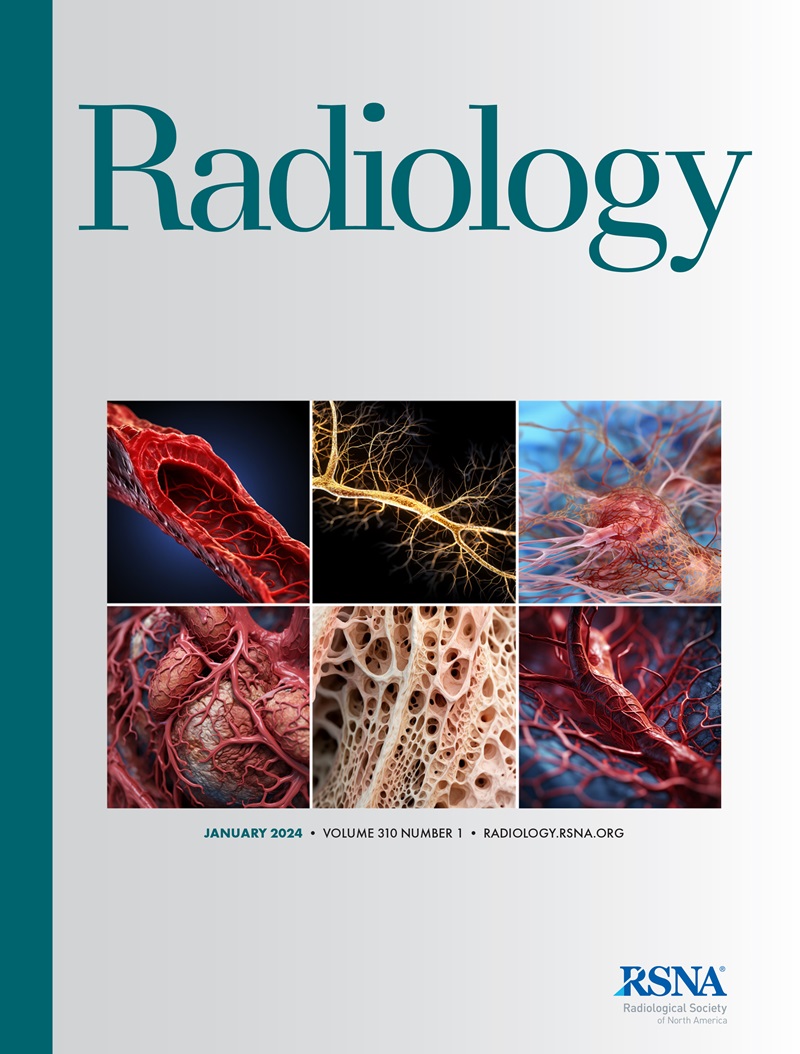下载PDF
{"title":"乳房致密且乳腺癌风险各异的女性接受美国辅助筛查的效果:乳腺癌监测联盟的结果。","authors":"Brian L Sprague, Laura Ichikawa, Joanna Eavey, Kathryn P Lowry, Garth H Rauscher, Ellen S O'Meara, Diana L Miglioretti, Janie M Lee, Natasha K Stout, Sally D Herschorn, Hannah Perry, Donald L Weaver, Karla Kerlikowske","doi":"10.1148/radiol.232380","DOIUrl":null,"url":null,"abstract":"<p><p>Background It is unclear whether breast US screening outcomes for women with dense breasts vary with levels of breast cancer risk. Purpose To evaluate US screening outcomes for female patients with dense breasts and different estimated breast cancer risk levels. Materials and Methods This retrospective observational study used data from US screening examinations in female patients with heterogeneously or extremely dense breasts conducted from January 2014 to October 2020 at 24 radiology facilities within three Breast Cancer Surveillance Consortium (BCSC) registries. The primary outcomes were the cancer detection rate, false-positive biopsy recommendation rate, and positive predictive value of biopsies performed (PPV3). Risk classification of participants was performed using established BCSC risk prediction models of estimated 6-year advanced breast cancer risk and 5-year invasive breast cancer risk. Differences in high- versus low- or average-risk categories were assessed using a generalized linear model. Results In total, 34 791 US screening examinations from 26 489 female patients (mean age at screening, 53.9 years ± 9.0 [SD]) were included. The overall cancer detection rate per 1000 examinations was 2.0 (95% CI: 1.6, 2.4) and was higher in patients with high versus low or average risk of 6-year advanced breast cancer (5.5 [95% CI: 3.5, 8.6] vs 1.3 [95% CI: 1.0, 1.8], respectively; <i>P</i> = .003). The overall false-positive biopsy recommendation rate per 1000 examinations was 29.6 (95% CI: 22.6, 38.6) and was higher in patients with high versus low or average 6-year advanced breast cancer risk (37.0 [95% CI: 28.2, 48.4] vs 28.1 [95% CI: 20.9, 37.8], respectively; <i>P</i> = .04). The overall PPV3 was 6.9% (67 of 975; 95% CI: 5.3, 8.9) and was higher in patients with high versus low or average 6-year advanced cancer risk (15.0% [15 of 100; 95% CI: 9.9, 22.2] vs 4.9% [30 of 615; 95% CI: 3.3, 7.2]; <i>P</i> = .01). Similar patterns in outcomes were observed by 5-year invasive breast cancer risk. Conclusion The cancer detection rate and PPV3 of supplemental US screening increased with the estimated risk of advanced and invasive breast cancer. © RSNA, 2024 <i>Supplemental material is available for this article.</i> See also the editorial by Helbich and Kapetas in this issue.</p>","PeriodicalId":20896,"journal":{"name":"Radiology","volume":null,"pages":null},"PeriodicalIF":12.1000,"publicationDate":"2024-08-01","publicationTypes":"Journal Article","fieldsOfStudy":null,"isOpenAccess":false,"openAccessPdf":"https://www.ncbi.nlm.nih.gov/pmc/articles/PMC11366666/pdf/","citationCount":"0","resultStr":"{\"title\":\"Performance of Supplemental US Screening in Women with Dense Breasts and Varying Breast Cancer Risk: Results from the Breast Cancer Surveillance Consortium.\",\"authors\":\"Brian L Sprague, Laura Ichikawa, Joanna Eavey, Kathryn P Lowry, Garth H Rauscher, Ellen S O'Meara, Diana L Miglioretti, Janie M Lee, Natasha K Stout, Sally D Herschorn, Hannah Perry, Donald L Weaver, Karla Kerlikowske\",\"doi\":\"10.1148/radiol.232380\",\"DOIUrl\":null,\"url\":null,\"abstract\":\"<p><p>Background It is unclear whether breast US screening outcomes for women with dense breasts vary with levels of breast cancer risk. Purpose To evaluate US screening outcomes for female patients with dense breasts and different estimated breast cancer risk levels. Materials and Methods This retrospective observational study used data from US screening examinations in female patients with heterogeneously or extremely dense breasts conducted from January 2014 to October 2020 at 24 radiology facilities within three Breast Cancer Surveillance Consortium (BCSC) registries. The primary outcomes were the cancer detection rate, false-positive biopsy recommendation rate, and positive predictive value of biopsies performed (PPV3). Risk classification of participants was performed using established BCSC risk prediction models of estimated 6-year advanced breast cancer risk and 5-year invasive breast cancer risk. Differences in high- versus low- or average-risk categories were assessed using a generalized linear model. Results In total, 34 791 US screening examinations from 26 489 female patients (mean age at screening, 53.9 years ± 9.0 [SD]) were included. The overall cancer detection rate per 1000 examinations was 2.0 (95% CI: 1.6, 2.4) and was higher in patients with high versus low or average risk of 6-year advanced breast cancer (5.5 [95% CI: 3.5, 8.6] vs 1.3 [95% CI: 1.0, 1.8], respectively; <i>P</i> = .003). The overall false-positive biopsy recommendation rate per 1000 examinations was 29.6 (95% CI: 22.6, 38.6) and was higher in patients with high versus low or average 6-year advanced breast cancer risk (37.0 [95% CI: 28.2, 48.4] vs 28.1 [95% CI: 20.9, 37.8], respectively; <i>P</i> = .04). The overall PPV3 was 6.9% (67 of 975; 95% CI: 5.3, 8.9) and was higher in patients with high versus low or average 6-year advanced cancer risk (15.0% [15 of 100; 95% CI: 9.9, 22.2] vs 4.9% [30 of 615; 95% CI: 3.3, 7.2]; <i>P</i> = .01). Similar patterns in outcomes were observed by 5-year invasive breast cancer risk. Conclusion The cancer detection rate and PPV3 of supplemental US screening increased with the estimated risk of advanced and invasive breast cancer. © RSNA, 2024 <i>Supplemental material is available for this article.</i> See also the editorial by Helbich and Kapetas in this issue.</p>\",\"PeriodicalId\":20896,\"journal\":{\"name\":\"Radiology\",\"volume\":null,\"pages\":null},\"PeriodicalIF\":12.1000,\"publicationDate\":\"2024-08-01\",\"publicationTypes\":\"Journal Article\",\"fieldsOfStudy\":null,\"isOpenAccess\":false,\"openAccessPdf\":\"https://www.ncbi.nlm.nih.gov/pmc/articles/PMC11366666/pdf/\",\"citationCount\":\"0\",\"resultStr\":null,\"platform\":\"Semanticscholar\",\"paperid\":null,\"PeriodicalName\":\"Radiology\",\"FirstCategoryId\":\"3\",\"ListUrlMain\":\"https://doi.org/10.1148/radiol.232380\",\"RegionNum\":1,\"RegionCategory\":\"医学\",\"ArticlePicture\":[],\"TitleCN\":null,\"AbstractTextCN\":null,\"PMCID\":null,\"EPubDate\":\"\",\"PubModel\":\"\",\"JCR\":\"Q1\",\"JCRName\":\"RADIOLOGY, NUCLEAR MEDICINE & MEDICAL IMAGING\",\"Score\":null,\"Total\":0}","platform":"Semanticscholar","paperid":null,"PeriodicalName":"Radiology","FirstCategoryId":"3","ListUrlMain":"https://doi.org/10.1148/radiol.232380","RegionNum":1,"RegionCategory":"医学","ArticlePicture":[],"TitleCN":null,"AbstractTextCN":null,"PMCID":null,"EPubDate":"","PubModel":"","JCR":"Q1","JCRName":"RADIOLOGY, NUCLEAR MEDICINE & MEDICAL IMAGING","Score":null,"Total":0}
引用次数: 0
引用
批量引用


